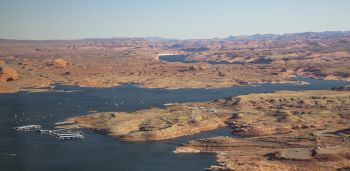O&M of a Reservoir: Difference between revisions
From ASDSO Dam Safety Toolbox
No edit summary |
No edit summary |
||
| Line 1: | Line 1: | ||
__NOTOC__ | __NOTOC__ | ||
[[Category:Reservoirs]] | |||
---- | ---- | ||
<!-- Delete any sections that are not necessary to your topic. Add pictures/sections as needed --> | <!-- Delete any sections that are not necessary to your topic. Add pictures/sections as needed --> | ||
| Line 16: | Line 17: | ||
Deposition of sediments in the reservoir is problematic as it reduces the reservoir’s potential storage capacity. These accumulated sediments can be removed in a variety of ways including sluicing through the bottom outlet of the dam (if one exists) and dredging. | Deposition of sediments in the reservoir is problematic as it reduces the reservoir’s potential storage capacity. These accumulated sediments can be removed in a variety of ways including sluicing through the bottom outlet of the dam (if one exists) and dredging. | ||
“Existing reservoirs are routinely surveyed to determine sediment deposition and resulting loss of storage”.<ref name="EM 1110-2-1420">[[Hydrologic Engineering Requirements for Reservoirs (EM 1110-2-1420) | Hydrologic Engineering Requirements for Reservoirs (EM 1110-2-1420), USACE, 1997]]</ref> | “Existing [[reservoirs]] are routinely surveyed to determine sediment deposition and resulting loss of storage”.<ref name="EM 1110-2-1420">[[Hydrologic Engineering Requirements for Reservoirs (EM 1110-2-1420) | Hydrologic Engineering Requirements for Reservoirs (EM 1110-2-1420), USACE, 1997]]</ref> | ||
==Best Practices Resources== | ==Best Practices Resources== | ||
Revision as of 02:56, 18 November 2022

|
| Lake Powell, the second largest reservoir in the United States by water capacity. (National Parks Service) |
Deposition of sediments in the reservoir is problematic as it reduces the reservoir’s potential storage capacity. These accumulated sediments can be removed in a variety of ways including sluicing through the bottom outlet of the dam (if one exists) and dredging.
“Existing reservoirs are routinely surveyed to determine sediment deposition and resulting loss of storage”.[1]
Best Practices Resources
![]() Hydrologic Engineering Requirements for Reservoirs (EM 1110-2-1420) (U.S. Army Corps of Engineers)
Hydrologic Engineering Requirements for Reservoirs (EM 1110-2-1420) (U.S. Army Corps of Engineers)
Citations:
Revision ID: 4333
Revision Date: 11/18/2022
